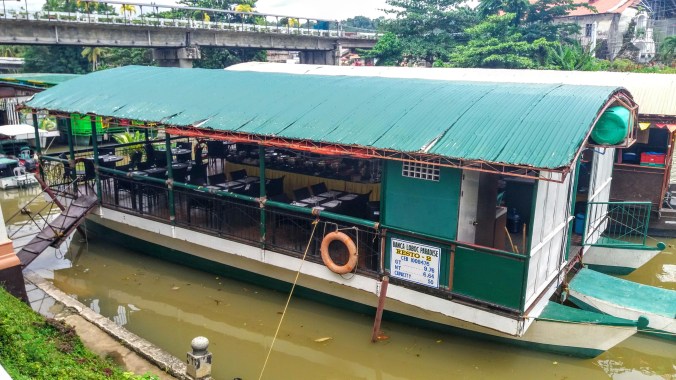On my last full day of vacation, everything on my Bohol checklist was done, but I was fighting for peace of mind after days of discord in what would turn out to be my shattered friendship. I will not air that laundry here, but it remains one of the hardest losses I’ve sustained in years. Seeking resilience and restoration that day, I turned toward the siren sounds of waterfalls. I adore waterfalls. Not only are they beautiful and fun if you can swim in them, but they also create negative ions. Any kind of massive moving water can do this, like pounding ocean surf or heavy rainstorms, even your shower. Studies started back in the early 2000s on the effects of negative ions on mood showed some promising results that walking on the beach when the waves are going, or visiting a waterfall can give you a major mood boost. Plus, they’re flippin’ gorgeous!
Mas Ago
 Mas Ago Falls is possibly the “most famous” of the Bohol waterfalls. I don’t mean to imply that it is famous, simply that of the dozens or more that dot the island, this one is better known and more often visited by tourists than any other. The drive time was a bit more than an hour, and there was a small fee to park my motorcycle and another small fee to enter the “park”. The parking attendant didn’t have any change so simply let me drive by and asked me to pay him as I left since the admittance fee collector would likely have change for me. She did, and also offered to hold my helmet in her office while I went down.
Mas Ago Falls is possibly the “most famous” of the Bohol waterfalls. I don’t mean to imply that it is famous, simply that of the dozens or more that dot the island, this one is better known and more often visited by tourists than any other. The drive time was a bit more than an hour, and there was a small fee to park my motorcycle and another small fee to enter the “park”. The parking attendant didn’t have any change so simply let me drive by and asked me to pay him as I left since the admittance fee collector would likely have change for me. She did, and also offered to hold my helmet in her office while I went down.

I started down a long series of steep stairs. The falls and the river are at the bottom of a gorge. I could hear the falls long before I could see them. The stairs were wide, sturdy and well maintained, so I felt quite safe. My favorite waterfall near Seattle, Murhut Falls, was the other way around, and many others I’ve visited have been as well: a climb to reach, and an easier descent back to the parking lot. I knew as I descended that I would pay for the privilege of waterfall hunting with the uphill return later.
When I arrived at the bottom, it was clear that there had been some changes in the path. One branch led to a viewing platform where visitors could get a nice photo. Broken stairs led from the viewing area to the water, most likely destroyed in the earthquake. The stairs that now lead to the water were “blocked off” by a small stick, which I ducked under and proceeded onward. I felt emboldened to do this because there were already people at the river. There had been a heavy storm the night before, and there were what I presume to be park employees sweeping debris from the rocks to pretty up the area. There was also a father and son who had come down to the river for an early morning wash. It was quickly evident that none of them had been expecting a tourist so early in the morning.
The other effect of the previous night’s storm was that the falls were engorged. Photos I saw online showed two thinner streams of water coming down the 8m drop into a turquoise pool below. The day I arrived, it was one very large waterfall moving massive amounts of water dangerously fast. The pool was far more peridot than turquoise, but the water was churning roughly and there were branches of fallen trees visible as well. I know better than to risk a river moving that fast, and as I stared at the water coming to terms with the fact that I would not be able to swim, one of the men sweeping asked me just that, “do you want to go swimming?”

Of course I did, but the water looked too dangerous, I replied. He showed me a spot further down the river, behind some large rocks where there were pools that were sheltered from the worst of the current and indicated they would be safe. In addition to the rocks, I noticed that part of a concrete staircase had fallen into the river here as well. I found some older pictures of the area online where the pool and river are clear, so I can only guess that the boulders and stairs now cluttering up the river were a result of the quake that affected so much of the region. Given the remote location of the falls and the size of the rocks, I doubt they’ll be cleared away, however they provided a nice shelter from the strong current, and in calmer times would be a great way to get out into the middle of the river for photo-ops.
I doffed my pants but kept the shoulder and back covering I’d worn over my swimsuit. It wasn’t modesty, but a desire to keep the sun away. I settled into a little pool between some rocks and enjoyed the blissfully cool water. The rocks are quite slippery, yet the native Filipinos had no trouble at all bouncing around from rock to rock as though they had the best traction available. I was only somewhat mollified when some of the passing tourists later also had trouble with the slippery rocks (no one was hurt, only dignity).
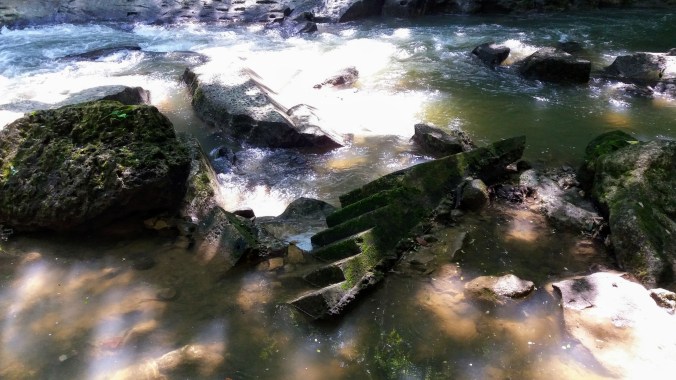
Before long, the sweepers finished and left, then the father and son departed as well, leaving me alone with the waterfall. I was having a little difficulty because I couldn’t get to a spot where I could sit in the water and see the falls at the same time, and so took to moving back and forth between sitting atop a large river rock and watching, and sitting beside that same rock and cooling my sunburn in the water. A few tourists came down the steps, but most just took a few pictures and headed back up. One couple did come down to the part of the river I was at, just to wet their toes, and these were the ones who slipped, as I had, on the rocks. I was less worried about keeping my clothes clean, however, and just resorted to scooting.
The most interesting visit of the morning was when a group of university students from the local college of tourism came down to ask me if they could do a video interview of me for a class project. As a teacher, I am morally obligated to help out with student projects whenever I can, plus they seemed nice, so I agreed and they came carefully down to the slippery rocks so they could film me there in the water, and I answered some questions about where I was from and how I was enjoying Bohol.
Despite a few tourists and students, most of my time at Mas Ago was spent in solitude. It was quiet and refreshing. After a couple hours, the negative ions and natural beauty started working on my mood and I began to feel that addictive surge of wonder and gratitude that I’ve come to associate with exploring the world.

When I left, I discovered everyone had gone for lunch. The main fee collection booth was empty and locked, although she had left my helmet on my bike, and when I tried to stop at the parking attendant’s booth to pay the fee I’d missed on the way in, he was gone too, and the barrier blocking traffic was propped up. It seems that while the tourist industry does want to collect their fees when possible, they aren’t too bent out of shape about people wandering in on breaks.
Google Inspired Adventures
My waterfall itch wasn’t quite satisfied, as I’d been unable to do much swimming, and had to keep my distance from the raging falls for safety. I pulled up my trusty Google oracle and searched the area simply for “falls” to see what would come up. Sure enough, the map showed two such designations within 30 minutes of my current location.
People gripe about millennials being attached to phones, and although I’m not actually millennial, I am attached to my phone. I bring it everywhere, I make sure to get a data plan and have a back up battery at all times. And yes, I like posting cool photos on Instagram or sharing updates on Facebook, but the real reason my phone is a critical accessory in world travel is that it is the ultimate guide book. I can look for attractions, find directions, translate labels or signs, and sometimes find hidden gems that I would never have even known to ask about. So, please, don’t judge people who are tethered to the device until you know what they’re using it for, because the next adventure would not have happened at all without my phone and my Google.
Malingin Falls
 After checking the routes, it seemed that even though it was farther as the crow flies, that it was closer as the motorcycle drives and so I headed over to this less well known waterfall site. After driving for a bit on well maintained roads, Google Maps directed me to turn down a dirt side road. I wasn’t especially bothered by this, since several places I’d visited during the last week were down this kind of side road. There was a sign at the intersection for the waterfalls. Although it was a very temporary kind of sign made of hanging vinyl, at least it told me I was headed the right way. As I continued down the road, the gravel and dirt gave way to mud and grass. I passed some bewildered locals and asked querulously if I was heading the right way to the falls. They indicated I was, so I kept on going.
After checking the routes, it seemed that even though it was farther as the crow flies, that it was closer as the motorcycle drives and so I headed over to this less well known waterfall site. After driving for a bit on well maintained roads, Google Maps directed me to turn down a dirt side road. I wasn’t especially bothered by this, since several places I’d visited during the last week were down this kind of side road. There was a sign at the intersection for the waterfalls. Although it was a very temporary kind of sign made of hanging vinyl, at least it told me I was headed the right way. As I continued down the road, the gravel and dirt gave way to mud and grass. I passed some bewildered locals and asked querulously if I was heading the right way to the falls. They indicated I was, so I kept on going.
Maybe I should have parked and walked a good bit earlier, but it was hot, and I was reasonably confident in my ability to keep driving as the road became more narrow. Once or twice I hit a mud puddle and slid around a bit, but I was going slow and making progress … until I wasn’t. I managed to drive right into a deep and long patch of mud that claimed the bikes tires and stopped me flat. Putting my feet down, I sank in the mud past my ankles, and I worked hard to get the bike unstuck, only running into the bushes once in the process. In retrospect, it might have been less work to walk the longer distance than to fight with the mud, but it wouldn’t have been as cool a story, and one of my favorite lifestyle adages is to live your life for the stories it creates.
I was finally forced to abandon the bike by the side of the path. I can’t call it a road anymore. I suspect that in drier times it would be easy to drive all the way to the stairs, but the previous night’s rainstorms made the road simply too slippery to drive past a point. I was a little worried about leaving my rental out in what felt like the middle of nowhere, but it seemed like the rural folk were a good deal more honest and trustworthy than city folk are rumored to be, and I had a reasonable expectation it would remain unmolested while I was away. I only walked a short distance before I began to hear the rushing of water that told me I was getting close, and in just a few more minutes, I crested a ridge that opened onto a little green river valley and a beautiful waterfall and swimming hole, complete with local swimmers.

There was another staircase down the ridge, but as it was also covered in slippery mud, I took off my mud covered sandals and proceeded down slowly, clinging to the railing, and where the railing was gone, sitting down and scooting once more. I can only imagine the ridiculous image I presented to the locals (who have no trouble at all navigating these slippery steps in flip flops) covered in mud from my struggles on the path, carrying my backpack and helmet and treating the steps like a dangerous mountainside. I made it to the field and began the trek through yet more mud, slipping and falling at least once when I took an incautiously large step. I began to wonder if all those pumice stone scrubbings I do to keep my feet soft were actually a bad idea because it seemed that every place I put my feet they tried to slide out from under me, but I did eventually make it all the way to the water’s edge where I was greeted with some amusement and much courtesy by the families already there.
I didn’t bother to change. Swimming clothed is common in most parts of Asia and the Philippines is no exception. Besides, my clothes were so muddy I’d be getting cleaner by swimming in them.

This was easily my favorite waterfall experience of the day. Although it was also the most challenging, I think in some ways that made it more valuable. The river and fields were just amazing. Talk about your basic Garden of Eden unspoiled natural environment! Although there were man-made additions, I thought they added to the experience. There was a kind of concrete mini-dam that formed a pool at the top of the falls and also a safety barrier to keep anyone from getting pulled over by the current (and a footbridge across). There were also some little huts to put belongings and enjoy picnics at while hiding from the sun. The main swimming area was well shaded under an enormous tree.
I was a bit worried about having awkward social encounters, but the people there were lovely. One woman admitted she was quite surprised to see me (although reassuring me I was very welcome) and asked how I had managed to find the place at all. Two teenagers who I think were siblings introduced themselves and chatted with me. The girl was excited when she found out I lived in Korea because she loves K-pop. The families enjoyed themselves taking photos of each other (and some selfies with me), jumping from the top of the falls to the pool below, running up and down the slopes and generally splashing it up.
My favorite thing to do was to rest against the barrier at the falls and let the water rush past me as I looked downriver at the beautiful jungle scenery.
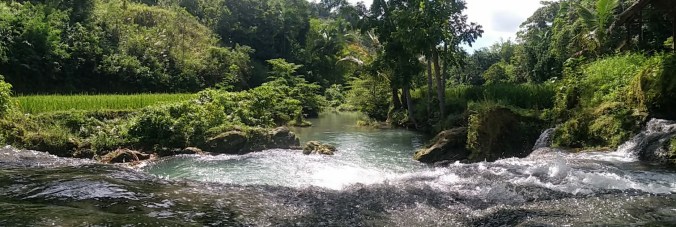
Eventually, the families started packing up, and although at first I thought I might stay longer, a group of young men showed up with a bunch of beer. It may have been no threat at all, but I’m afraid my life experiences simply don’t allow me to feel safe as the only woman in a group of men with alcohol in the middle of the woods… yeah, there’s no way not to make that sound like the beginning of a horror movie. I think if anyone else was staying I wouldn’t have been driven off by the young men, but I’d had such a pleasant experience so far, I didn’t want to risk it becoming uncomfortable, or dangerous, so I decided to leave as well.
Solo Female Traveling Safety
I do want to point out that I did not feel unsafe anywhere in Bohol. The worst thing that happened was a guy who came over to talk to us in the ocean the one time we were out after dark, and he was totally friendly. It’s so hard to judge men’s intentions when I’m traveling as a female alone (or with only another female companion). Many folks around the world ask about things like age and marriage by way of friendly conversation and I’ve had lots of women ask me these questions, no problem. Unfortunately, when men ask, I can’t be sure if they just want to chat or if they are scoping me out for anything from easy sex to potential wife. And I’ve encountered the whole range. Some men I’ve met have been lovely to talk with and I’m happy to keep in touch after we part ways. Others made me wonder if it was worth calling the police over. But the vast majority are in a gray middle ground of making me feel vaguely uncomfortable without doing anything overtly “wrong”.
With the “me too” campaign underway, it’s hard not to think about my negative experiences at the hands of men in the US and around the world: taxi drivers who’ve tried to cop a feel or propose marriage in the Middle East. A well meaning festival goer in Japan who insisted my life was unfulfilled without a husband, who insisted on taking my hand in the crowd, and who is still sending me messages 2 years later even after being told “thanks but no thanks” as politely as I can. And I don’t even want to get into anything worse, but yeah, it’s there. I’m sad and angry that I have to live my life assuming that a man is a predator until proven otherwise, but if you as a man are upset that women are treating you like a threat, don’t get mad at us, get mad at all the men who creep, harass, and assault, leaving us with no choice but to live on the defense.
Filipino men may all be perfect gentlemen, I don’t know, but I do know it’s not worth taking the chance. So, I wrung out my clothes and gathered my things and followed the teenagers up the steps.
Stuck in the Mud
I had almost as much trouble going up as coming down, and one older gentleman paused to give me a hand. In this case, my nervousness at taking his hand was that he was not braced on anything and I was sure that adding my weight to his would cause us both to slip down the concrete sairs and split our skulls open, but he stood firmly and confidently and helped me up the steepest parts until I could reach the railing and manage on my own. I am sure they’re hiding super feet, either suckers or tiny hooks… I honestly have no idea how everyone was so sure footed on the mud and algae covered rocks and stairs. Island magic.
I got back to my bike, which was right where I left it, and bid the kids farewell as I began to ride back up the trail. When I encountered the mud patches on the way back, I got off the bike and walked it around, my shoes dangling from the handlebars to keep them mud free. This worked fairly well for the first two or three puddles, but soon I came upon a huge low place in the road. Somehow I’d ridden through it on my way in, but looking at it on the way out it seemed like an impassable lake. To drive home the metaphor, I spotted a water buffalo up to it’s shoulders just next to the road. I tried two times to progress and was forced backward each time after only a step or two.

While I stood at the edge of the watery road debating the best path through the mud and marsh, the teenagers who were on foot caught up with me (more evidence I should have just left the bike back at the first mud puddle on the way in). They quickly realized my conundrum and politely refrained from telling me how silly I’d been to drive in this far with the roads in this condition (literally everyone else I’d seen that afternoon was on foot, although I had seen a few more bikes parked on the path). The young man graciously began to poke around the mud for the shallowest path through, guiding me and my bike wide around the road up into the grass, through the trees, and eventually back down on the other side of the huge morass. I suppose I would have gotten through eventually, but who knows how long it would have taken or how many more times I would have been stuck.
 I was humbled by the absolute unselfish behavior of these teens. They were kind and patient, and generally the type of teenagers no one thinks exist anywhere in the world (love Facebook, K-pop, and their phones, but are kind and helpful to each other and strangers?). I hope that their lives are as good as they are.
I was humbled by the absolute unselfish behavior of these teens. They were kind and patient, and generally the type of teenagers no one thinks exist anywhere in the world (love Facebook, K-pop, and their phones, but are kind and helpful to each other and strangers?). I hope that their lives are as good as they are.
I bid them farewell when they reached their homes, and I made it back to the main road without further incident. I was covered in mud to the knees again. I didn’t want to put on my shoes and I didn’t want to drive far barefoot, so I drove just far enough until I saw a little roadside convenience stand.
I couldn’t find anyone, but it seemed that the cashier window was open (or at least not boarded up), so I called out to see if someone was around. The building itself was attached to more domestic looking structures and hanging laundry was also visible. Eventually, some small children noticed me and one girl came over to sell me a packet of cookies and a large bottle of water. They were a bit flustered at having to make change (I was always running out of small coins), but managed it in the end and I sat down on the bench out front to clean up and have my snack. The mud hadn’t had time to dry yet, so rinsing my feet was easy enough, and once they were mud-free I was able to put my shoes back on and do some more serious driving.
Kawasan Falls
The third waterfall was another 20 or so minutes away according to Google, and I wasn’t sure I was up for another slog through the mud, no matter how wonderful the prize at the end. I debated for a while and decided to head over anyway, promising myself that if the road was too muddy, I would turn back. (the lies we tell ourselves)
I followed the directions along the main roads, finally finding the side road in question. There was another sign indicating that this was the way to Kawasan Falls. The side road was under construction, perhaps someone in the tourism industry realized that muddy dirt roads are a solid deterrent to the average tourist. I was somewhat encouraged at the easier drive, although the road workers laughed a bit as I passed by, they assured me that I was on the right road to the falls. I guess that solo motorbiking foreign women are not a common sight on Bohol.
Eventually, the construction ran out, and the road returned to it’s former dirt and gravel state, however places that would have otherwise been mud pits had been filled in with more gravel, making the overall drive much less sticky. It was still a bumpy, uneven, rocky road, but the mud puddles were avoidable and I was able to press on without having to turn back from obstacles. There was a bit of a lawn at the end of the road that was being used as a parking lot and a park attendant sitting next to the path through the trees. Once I was parked, he led me through a little trail to a haphazard entrance pavillion where a young lady collected the small entry fee. The man continued to lead me down the path, although it was the only one and there was no way I could have gotten lost.
We passed some small feeder falls, and a series of elevated huts which I assume could be rented out for a day to have your family gathering and picnic at with a great view of the falls and the downstream river. It was obvious that this site was gunning to become a bigger attraction. There were plenty of locals already there enjoying the day. Once we were in sight of the falls, the guide released me on my own recognizance. It was easily the most crowded place I’d visited that day. I’m not sure if it was the time of day or if because this location had easier access it was just more popular.

I waved hello to a bench full of locals who were tickled pink to see me there. I found a tree to dump my bag, shoes and helmet at and set about trying to figure out how to get out to the swimming area. Again, I observed that all the Filipinos have magical feet. As I was moving out toward where some kids were swimming one of the little girls stopped me with a warning about how slippery the rocks were, and I headed off disaster or at least embarrassment. While trying to get out another way, I got approached for some more ‘selfies with the tourist’. Sometimes I wonder if I look like someone famous. I don’t think my appearance is especially remarkable, and yet it seems to give people joy to take pictures with me. I don’t get it, but it’s harmless as far as I know, and doesn’t cost me anything to make someone else happy, so I do it. I hesitate to imagine how many random group photos I’m in from around the world.
Of the three falls I saw that day, although Malingin was my favorite overall experience, there is no contest that Kawasan was the most stunning visually. (Not to be confused with Kawasan over in Cebu which is super famous and crowded with tourists from what I hear). It was much taller than the other two, and of course because of the previous night’s rains it was pouring a magnificent amount of water. Despite the torrent, a group of young men had climbed up the rock-face (no stairs, no handholds, just magic feet) and were sitting behind the falls. Lots of kids and moms with little ones were in the shallower pools, and a few more emboldened swimmers were out in the deep pool directly beneath the falls.
I am a confident swimmer, so I was happy to get right up close. I ended up perching against some large rocks in the pool to rest and just take in the scenery. It was the pinnacle of what I had hoped for when I set out to swim under a fall that day, since I was submerged in the cool water only a few meters from the downpour, the strength of the wind created by the falling water blowing the wonderful clean smell (and negative ions) over me while I gazed upward to the sun-sparkled peak where the water leapt over the edge like liquid diamonds.
After a little while of pure “oh my god, this is my life” feelings, I noticed that the young men up on the sheer rockface were standing up and preparing to jump. I have nothing against jumping into water. I like diving. I may be overly paranoid about jumping into water I’m unfamiliar with, but I think it’s safe to assume these young men were regulars at this particular swimming hole. Nonetheless, it was a nailbiting scene, and it was clear that even the jumpers were more than a little nervous, one even performing a sign of the cross before leaping into the air. Everyone below watched and cheered so it became a group spectator sport and when they returned to the shore, the young men were welcomed by their waiting wives and girlfriends.
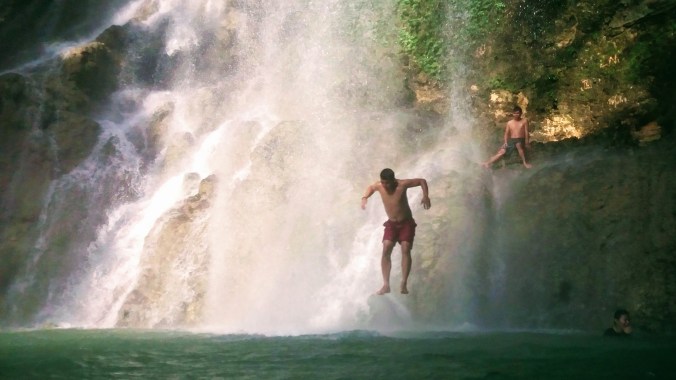
One of them asked me if I wanted to try, and while I might have been ok with the jumping part, when I asked them how they even got up there in the first place, they pointed to a section of wall that looked incredibly vertical and slippery, so I declined. I did try my luck at getting closer to the falls, although I only made it about halfway across the deep pool before the current and force of the wind drove me back, but it was exhilarating to be able to get so close to so much natural beauty and power.
After I retreated back to the resting rock, I was approached by yet another set of tourism students from the university, out collecting interviews for what was very likely the same class project. Of course I agreed to appear on camera, but I can’t help imagining what that class will be like when they show their projects and two separate groups with interviews at two separate waterfalls show up with the same tourist in their report!
I would have happily stayed until it was too dark to see or I got kicked out. Especially because around this time the crowds started thinning out and I got to take some totally human free photos of the magnificent scenery. However, I had made dinner plans for my last night in town and didn’t want to cancel. Thus, I clambered cautiously back through the shallow pools filled with pointy rocks, gathered my belongings, and climbed back out of the river valley as the golden light of the afternoon sun cast it’s glow on the quiet jungle around me.

And so ends the Chuseok Philippine Holiday. Like all the very best vacation posts, it takes me months to process all the stories and photos. My goal is always to get one vacation fully published before the next one, and while I didn’t have a winter vacation this year, I am doing a major upheaval in March as I move to a new city in Korea, rent my first Korean apartment on my own, and start a new job, so that seemed like a good deadline. I don’t know how much time I’ll have in March to write, but I hope that as the weather warms up and the flowers come out in April, I’ll have a cavalcade of new stories about this next leg of my journey. As always, you can see the full photo album on Facebook. Thanks for reading!




 Monday:
Monday:






















 She took up a nearby lamp and shone it into the depths so that I could see the water below.
She took up a nearby lamp and shone it into the depths so that I could see the water below.

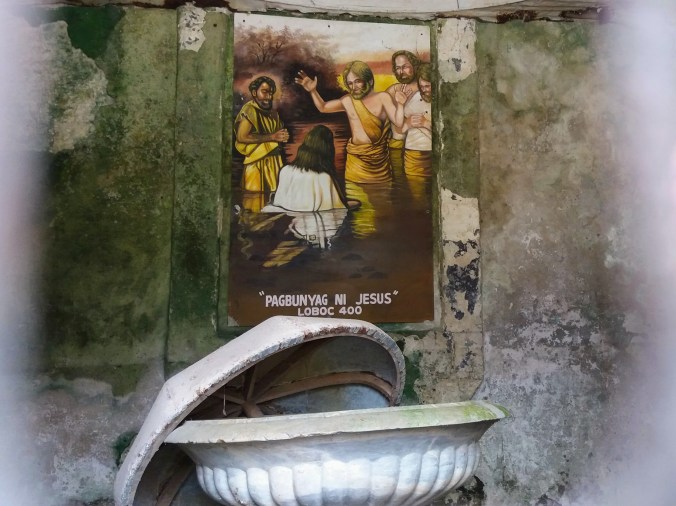


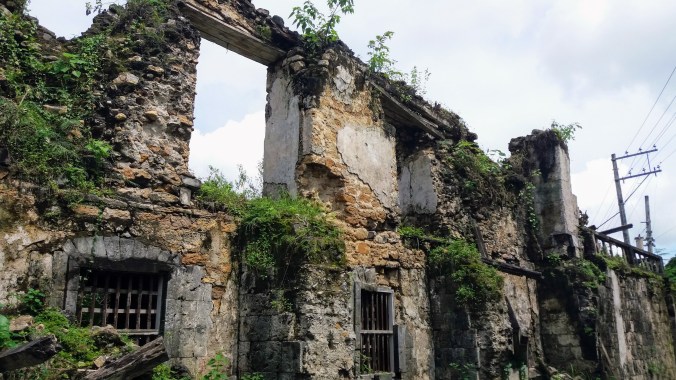

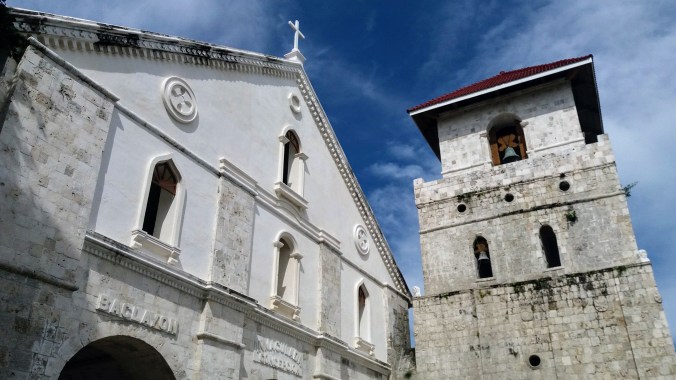 There is very little sign of damage on the exterior. This is not because the damage was minimal, but because the effort has been great. There was a before and after photo out front as well, showing what the damage looked like just after the quake and it’s much closer to what Loboc Church still looks like. I wandered around the exterior taking more photos and found several more blocks with that organic sea-life look that I now know to be coral stone. It seemed that the sanctuary proper was still under construction, but it is scheduled to re-open this year.
There is very little sign of damage on the exterior. This is not because the damage was minimal, but because the effort has been great. There was a before and after photo out front as well, showing what the damage looked like just after the quake and it’s much closer to what Loboc Church still looks like. I wandered around the exterior taking more photos and found several more blocks with that organic sea-life look that I now know to be coral stone. It seemed that the sanctuary proper was still under construction, but it is scheduled to re-open this year.






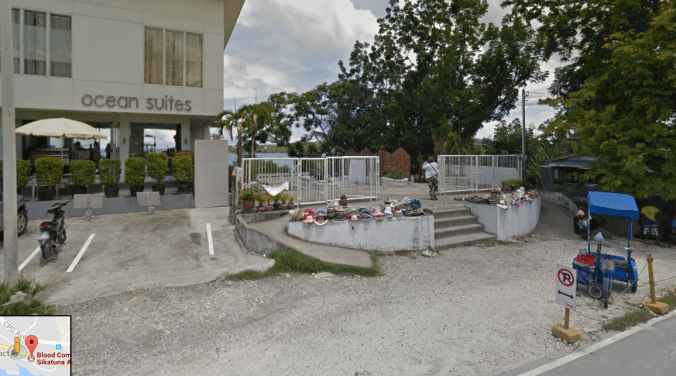





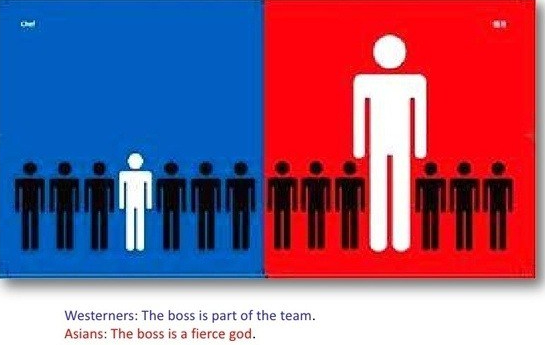 Not only are the schools massively different depending on if it’s A-D, elementary, middle, or high, all the schools have drastically different policies that come from the principal. Many of them will push to see how much extra work they can get you to do. You could try to force the letter of the contract (although it’s best to do that only as a very last resort because people will resent it), but it’s wiser to find culturally sensitive ways to stand up for yourself at work. Politeness will go a long way to smoothing the trail, but how you’re treated is going to be wildly different from everyone else in your intake because the principals make 70% of the rules, and the CTs make another 10-20%.
Not only are the schools massively different depending on if it’s A-D, elementary, middle, or high, all the schools have drastically different policies that come from the principal. Many of them will push to see how much extra work they can get you to do. You could try to force the letter of the contract (although it’s best to do that only as a very last resort because people will resent it), but it’s wiser to find culturally sensitive ways to stand up for yourself at work. Politeness will go a long way to smoothing the trail, but how you’re treated is going to be wildly different from everyone else in your intake because the principals make 70% of the rules, and the CTs make another 10-20%.
 Respect flows in order from job title to age to nationality. You are pretty much at the bottom of this. (you’re lower down than the Koreans who are younger than you… ) You shouldn’t object, or say no, or in any way be direct about any negative feedback. You get a little latitude because most of them know you don’t know the Korean WAY, but it’s easy to step on a cultural landmine or simply be confused as to why things are done this way.
Respect flows in order from job title to age to nationality. You are pretty much at the bottom of this. (you’re lower down than the Koreans who are younger than you… ) You shouldn’t object, or say no, or in any way be direct about any negative feedback. You get a little latitude because most of them know you don’t know the Korean WAY, but it’s easy to step on a cultural landmine or simply be confused as to why things are done this way. Your CT is the most important person to have a good relationship with at your school, and possibly in Korea. This is the difference between a good work life and a shitty one.
Your CT is the most important person to have a good relationship with at your school, and possibly in Korea. This is the difference between a good work life and a shitty one.

 The schedule is never what it says it will be. Ever. You will be told about events when they happen, or if you’re lucky, the day before.
The schedule is never what it says it will be. Ever. You will be told about events when they happen, or if you’re lucky, the day before. There is an expectation in Korean culture about your body being at work = you are working. Public schools are actually better than private companies because most of the time the Korean staff can actually show up and leave at designated times instead of trying to beat the boss in and wait until the boss leaves to go. As the foreigner teacher, you have a strict time in and time out and if they ask you to do more they have to agree to OT. Don’t agree to stay late until you get that OT approved, because they WILL try to get you to “volunteer”, and according to your contract, if you volunteer, they don’t have to pay you more.
There is an expectation in Korean culture about your body being at work = you are working. Public schools are actually better than private companies because most of the time the Korean staff can actually show up and leave at designated times instead of trying to beat the boss in and wait until the boss leaves to go. As the foreigner teacher, you have a strict time in and time out and if they ask you to do more they have to agree to OT. Don’t agree to stay late until you get that OT approved, because they WILL try to get you to “volunteer”, and according to your contract, if you volunteer, they don’t have to pay you more. Your holidays and sick leave aren’t exactly what you think they are. EPIK teachers get 11 sick days, and it says in your contract that for more than 3 days you need a doctor’s note. BUT. That actually means any non-consecutive 24 hours.
Your holidays and sick leave aren’t exactly what you think they are. EPIK teachers get 11 sick days, and it says in your contract that for more than 3 days you need a doctor’s note. BUT. That actually means any non-consecutive 24 hours. The school computers are all awful. Get a VPN. I can only erratically access my Google Drive from school because of the network’s security features. Sometimes, I can’t even copy images off the internet which is bad when you’re trying to make a PowerPoint and need that clip art. Sometimes one program will only work with the VPN and another will only work without it, so I have to keep turning it off and on. One day Drive needs the VPN, but the next day it won’t work with the VPN on. Some days, I have to turn the VPN off and on again every few minutes because the school’s network keeps blocking me… I swear I’m not trying to watch porn, I’m usually just trying to get to a picture of a cat eating a hamburger.
The school computers are all awful. Get a VPN. I can only erratically access my Google Drive from school because of the network’s security features. Sometimes, I can’t even copy images off the internet which is bad when you’re trying to make a PowerPoint and need that clip art. Sometimes one program will only work with the VPN and another will only work without it, so I have to keep turning it off and on. One day Drive needs the VPN, but the next day it won’t work with the VPN on. Some days, I have to turn the VPN off and on again every few minutes because the school’s network keeps blocking me… I swear I’m not trying to watch porn, I’m usually just trying to get to a picture of a cat eating a hamburger. There will be a lot of cultural misunderstandings. And just because one Korean person explains Korean culture a certain way, doesn’t mean it’s that way for every Korean. I mean, does everyone in your culture represent it the same way? If you feel confused or upset, try to find the specific reason for those feelings, and after you’re calm, ask to talk with your CT about it. Ask about the Korean perspective, and let them know your cultural perspective, not to try to get them to change, but so you can understand each other better and find something that works. One CT does not think a teacher should ever have their hands in their pockets in class. Another CT might have her hands in her pockets regularly. Is that Korean culture? No, but they might tell you it is.
There will be a lot of cultural misunderstandings. And just because one Korean person explains Korean culture a certain way, doesn’t mean it’s that way for every Korean. I mean, does everyone in your culture represent it the same way? If you feel confused or upset, try to find the specific reason for those feelings, and after you’re calm, ask to talk with your CT about it. Ask about the Korean perspective, and let them know your cultural perspective, not to try to get them to change, but so you can understand each other better and find something that works. One CT does not think a teacher should ever have their hands in their pockets in class. Another CT might have her hands in her pockets regularly. Is that Korean culture? No, but they might tell you it is.
 Most of this is EPIK specific, but that “K” does stand for Korea, so…
Most of this is EPIK specific, but that “K” does stand for Korea, so… I know I wrote some discouraging words, but trust me I’ve written far more about my wonderful experiences here. Korea, like every country on earth, is not perfect, but it’s got a lot going for it, and EPIK public school teaching is a great way to get to experience it all. I hope those of you reading this looking for advice or in anticipation of your upcoming trip to Korea will learn from my experiences, good and bad, and make your own great adventures in the upcoming school years.
I know I wrote some discouraging words, but trust me I’ve written far more about my wonderful experiences here. Korea, like every country on earth, is not perfect, but it’s got a lot going for it, and EPIK public school teaching is a great way to get to experience it all. I hope those of you reading this looking for advice or in anticipation of your upcoming trip to Korea will learn from my experiences, good and bad, and make your own great adventures in the upcoming school years.












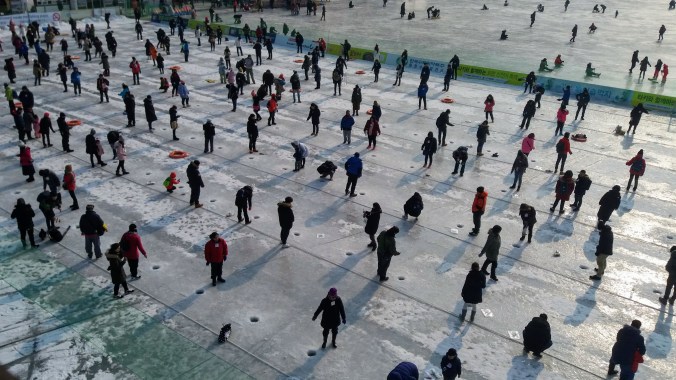




 With only one more wrong turn (I foolishly went into the building labeled Foreigner’s Fishing thinking I might pick up my rental rod there, but nope) I at last had my tiny blue fishing rod and my own hole in the ice. As I stood there working out the fishing technique by watching others, I began to relax and look around. I might have a small clue why people enjoy fishing other than eating fish. I was dubious of how this would work because our hooks had no bait, only a lure. It didn’t take long before the first person near me caught a fish and hauled it flopping out of the freezing water and onto the ice.
With only one more wrong turn (I foolishly went into the building labeled Foreigner’s Fishing thinking I might pick up my rental rod there, but nope) I at last had my tiny blue fishing rod and my own hole in the ice. As I stood there working out the fishing technique by watching others, I began to relax and look around. I might have a small clue why people enjoy fishing other than eating fish. I was dubious of how this would work because our hooks had no bait, only a lure. It didn’t take long before the first person near me caught a fish and hauled it flopping out of the freezing water and onto the ice.


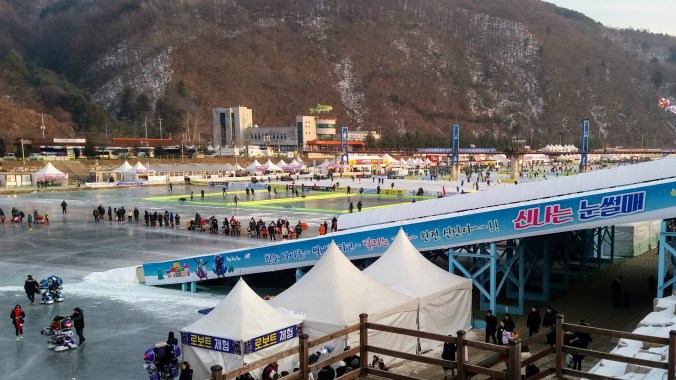
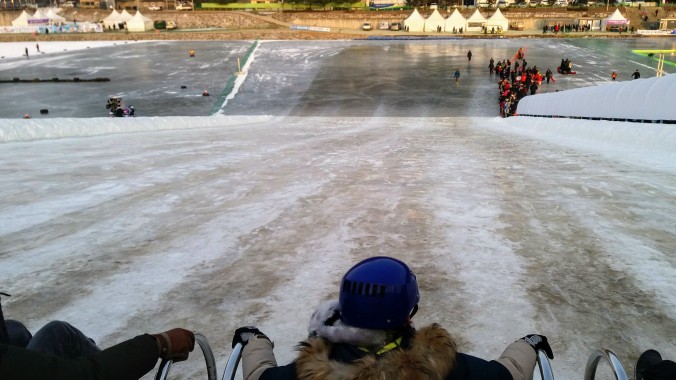

 The only actual tour I signed up for in the whole 9 day holiday was the firefly tour. After my
The only actual tour I signed up for in the whole 9 day holiday was the firefly tour. After my  When we arrived, it was at a small riverside dock where several other drivers also unloaded vans full of tourists and we were herded onto a large boat in the Loboc river. Once all aboard, we drove up into the mangroves. The night was amazingly beautiful. It happened to be a full moon and the river was wide enough to make a space around us and let the moonlight illuminate the trees and mountains in pale blue. The night air was warm, but the wind of the boat’s passage kept us cool and bug free. I was a little put off by the huge crowd, but it was a beautiful night and I was enjoying the scenery nonetheless. People had pointed to one or two lone flashes, wondering if that was the bugs we were coming to see, but of course it was not.
When we arrived, it was at a small riverside dock where several other drivers also unloaded vans full of tourists and we were herded onto a large boat in the Loboc river. Once all aboard, we drove up into the mangroves. The night was amazingly beautiful. It happened to be a full moon and the river was wide enough to make a space around us and let the moonlight illuminate the trees and mountains in pale blue. The night air was warm, but the wind of the boat’s passage kept us cool and bug free. I was a little put off by the huge crowd, but it was a beautiful night and I was enjoying the scenery nonetheless. People had pointed to one or two lone flashes, wondering if that was the bugs we were coming to see, but of course it was not.



 I took lots of photos, most of which are nearly identical in retrospect, and a few videos which I’ve managed to string together to give a general impression of the experience (see below). My seat provided an unrivaled view of both sides and a constant breeze that kept me cool and comfortable. Boat staff offered to take pictures (with my own camera, not as a souvenir gimmick), and when I was ready to go get my seconds of maja blanca, I offered my spot at the railing to a young lady with a very serious camera who I thought would appreciate the vantage point while I wasn’t using it.
I took lots of photos, most of which are nearly identical in retrospect, and a few videos which I’ve managed to string together to give a general impression of the experience (see below). My seat provided an unrivaled view of both sides and a constant breeze that kept me cool and comfortable. Boat staff offered to take pictures (with my own camera, not as a souvenir gimmick), and when I was ready to go get my seconds of maja blanca, I offered my spot at the railing to a young lady with a very serious camera who I thought would appreciate the vantage point while I wasn’t using it. We pottered down the river, admiring the plants and scoping out some other floating platforms where we theorized the dance performances would be held. At one point, I began to notice lamp posts along the riverside, seemingly alone in the jungle. I suppose that there may have once been a path there, perhaps wiped out by the 2013 earthquake or just by the changing course of the river, but it was more than a little Narnian to see a perfectly normal lamppost in the woods.
We pottered down the river, admiring the plants and scoping out some other floating platforms where we theorized the dance performances would be held. At one point, I began to notice lamp posts along the riverside, seemingly alone in the jungle. I suppose that there may have once been a path there, perhaps wiped out by the 2013 earthquake or just by the changing course of the river, but it was more than a little Narnian to see a perfectly normal lamppost in the woods.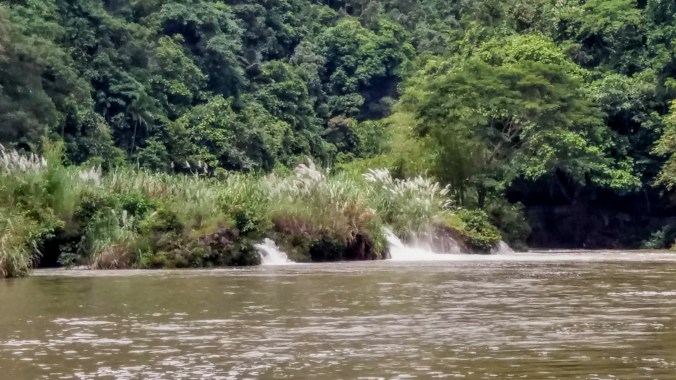 If you’ve ever been up and down a river, you’ll appreciate that the view on the way back is not actually the same as the view on the way out, so I didn’t mind at all. Plus, on the way back we pulled up to one of the floating platforms and got treated to some local traditional dancing. The sign indicated the dance is called Kuradang, which seems to be a kind of dance used at many celebrations in Bohol. It likely started before the Spanish colonization but has just as likely been influenced over the centuries. It’s still special here, though, because it’s considered to be a uniquely Boholano dance.
If you’ve ever been up and down a river, you’ll appreciate that the view on the way back is not actually the same as the view on the way out, so I didn’t mind at all. Plus, on the way back we pulled up to one of the floating platforms and got treated to some local traditional dancing. The sign indicated the dance is called Kuradang, which seems to be a kind of dance used at many celebrations in Bohol. It likely started before the Spanish colonization but has just as likely been influenced over the centuries. It’s still special here, though, because it’s considered to be a uniquely Boholano dance.

